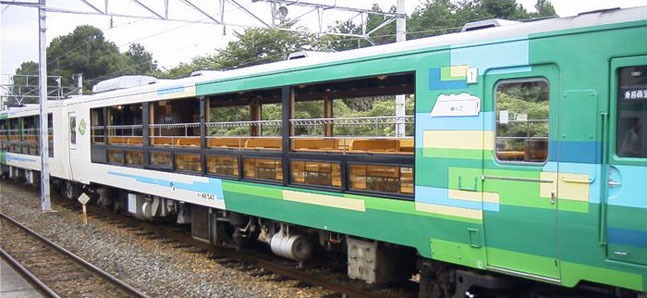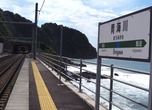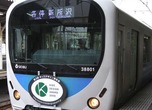
Posted: Thu Aug 19 2010
Train travel could very well be the most often chosen mode of escaping the Tokyo metro area to your summer holiday destination. In a departure from the utilitarian approach to train travel as a means of getting from A to B, recently the number of people choosing to travel by train purely for the ride in on the rise. While there are plenty of interesting trains out there, now is the time to zero in on the best summer rides by feeling the breeze on one of outer Tokyo’s trolley cars.
Watarase Keikoku Railway
This line runs from Kiryu Station on the Ryomo Line (in Gunma prefecture), along the Watarase River. Close to the last stop is Ashio Dozan (Ashio Copper Mine), which helped support Japan through its modernisation in the Meiji period. As an adverse effect of this progress over 100 years ago, nothing could live in the Watarase River due to the poisonous confluence from the copper mine. These days, however, it has become a verdant mountain river. The trolley car departs from Omama Station and takes an hour and 40 minutes to get to Ashio. This line has plenty of other attractions aside from the trolley car: along the way at Mizunuma Station there is a hot spring inside the station, while next to Kodo Station is an express carriage that used to run on the Tobu Line and now serves as a restaurant.
As the wind breaks the surface of the Watarase River, the train travels upstream. The train nears Tsudo Station, one stop from the Ashio Station, there is a complete change of scenery: a bare gash of land devoid of trees in this once commercially flourishing area. The fumes from the copper mine killed off all the trees on the mountain. Forty years on, the trees still have a hard time growing, so a local volunteer group has set up a tree-planting programme.
While Ashio’s more prosperous days are a thing of the past, the big copper mine still holds an important place in Japan’s modernisation. At a sightseeing spot for the mine, located not far from Ashio Station, it’s possible to learn more about the what the mine was like back in the day and the seriousness of the Japan’s first large scale case of mine pollution.
Website: www.watetsu.com
Aizu Railway
Take a two-and-a-half-hour train ride on a Tobu Railway express train from Asakusa – passing through Kinugawa Onsen, the biggest hot spring area in Kanto – and finishing up at Shin Fujiwara Station, where you can change directly to the Aizu Railway. From there, and over the next hour, the train crosses through the borders of Tochigi and Fukushima prefectures, then just as you see signs of civilization, the trolley car will be almost at its final stop—Aizu-Tajima in Fukushima. The name of trolley car (Aizu Roman Wind, Flower or Star) depends on the number and the service. Despite the difference in the names, all of the trains are the same.
This trolley car’s special feature is its sitting carriage. There are three carriages in the trolley, which have been designed to make the experience more enjoyable: an open carriage, a tatami mat carriage where you take off your shoes, and a carriage with huge windows, which allow for an amazing view. On the trolley car is a large illustration of Basu Ekicho, the honorary (and furry) station master of Ashinomaki Onsen Station. Basu Ekicho has been at the station since 2000 and in 2008, the cat was appointed as the station master. Needless to say, following this the Aizu Railway became synonymous with Basu Ekicho.
The journey passes the high cliffs, which line the banks of the Agano River, taking one and a half hours to reach the terminus at Aizu Wakamatsu. It is a nostalgic journey where you can experience the good old days of Japanese mountain villages, idyllic woodlands and castle towns all in the one ride.
Website: www.aizutetsudo.jp
Oigawa Railway
In the latter half of the 1970s, steam trains were taken off the tracks across Japan, however soon after, the trains they were brought back into operation drawing a large number of fans. Later much loved exceptional trains such as the Odakyu Romance Car, Kintetsu Vista Car and Nankai Zoom Car were re-introduced one after another taking a second go at the rails. For most railway fans, Shizuoka prefecture’s Oigawa Railway, located about one hour from Tokyo by the shinkansen high-speed train, is almost like experiencing a fully working railway museum.
There are two parts to the Oigawa line; the first part is a line, which stretches 40km from Kanaya Station on the JR East’s Tokaido Line to Senzu Station. Running on this line are SL trains, and trains that used to run limited express routes in various areas. Over the course of an hour and 20 minutes the railway goes upstream along the Oigawa River – which ironically was once a hindrance to travellers on the Tokaido – and arrives in Yamaai no Sato (Senzu Station). This is the final stop for the trolley car, and the beginning of the second part of the journey, where the expansive Oigawa River turns into a ravine. The trolley car continues along a fairly high section of the mountainside. The valley here is the Sessokyo, and the train takes sharp curves as it travels along the river. Finally the Abt system rack-railway appears. This railway has a toothed railway track which mesh with cog wheels that are fitted onto the train for traction while going up and down steep sections of track. Although this system can often be seen on European mountain railways, this is the only one in Japan. Along the way, the train passes over the Seki no Sawa Bridge, which at 100m above the water is the highest rail bridge in Japan. Travelling slowly for the benefit of its passengers, the open trolley car definitely gives the ultimate in thrills.
Website: www.oigawa-railway.co.jp
Usuitouge Railway Bunkamura
The quickest way to get from Tokyo to Nagano is via the Nagano Shinkansen. From Tokyo to Nagano it takes about one hour and 40 minutes. When the railroad first opened in the Meiji era, they must have thought they were dreaming, seeing this training running at such speed. At the time, the most difficult spot was a 10km mountain pass that ran along the border of Gunma and Nagano prefectures that featured a 550-metre vertical drop, and took an hour and 20 minutes to get through. For this section only, a locomotive was attached to help push the train, and as the train climbed the mountain there was continued worry about smoke in the tunnels.
Although the trains later went electric, for a long time afterwards they still attached an engine to help to push the train. Due to the train having to make a long stop at the bottom of the pass’s Yogawa Station to connect the engine, a specialty bento lunchbox was sold there, called ‘Touge no Kamameshi’. In 1997, Usuitoge was replaced by the shinkansen, closing the curtain on an over 100-year history.
Established in a space adjacent to Yokogawa Station on JR East’s Shinetsu line, is Usuitoge Testsudo Bunkamura which features a display of carriages from trains from various areas. On the grounds is an example of a trolley car, which used to run on the Usuitoge Line, which was never actually in service. While this is just one of a number of railway heritage parks across the country, it’s the trolley car that has an important role in the history of Japanese railways.
While the ride takes passengers only a short 2.6km of the more than 10km section, it is possible to get a feel for the train that travelled along the mountain pass back in the day. The last stop is Touge no Yu, an onsen hot spring complex. It’s possible to drive the real locomotive that used to push the train at the Touge mountain pass inside Bunkamura if you take a lesson. Have a go at pulling on the lever of this much-loved train nicknamed the ‘Touge Sherpa’ by fans.
Website: www.usuitouge.com/bunkamura
Kazekko Go
This last one is not a railway line, but a train run by JR East. So far, all of the four trolley cars have been private railways or sightseeing lines. However, Kazekko Go, which is owned by JR East, runs on lines across Eastern Japan. Each summer it runs on a different line, and the closest it will be to Tokyo this summer was on August 7 and 8 when it ran on the Tadami Line (a not-so-popular line which links Niigata and Fukushima), and on August 28 and 29 when it runs on the Watarase Keikoku Line.
Website: www.jreast.co.jp/train/joyful/kaze.html
Tweets
- About Us |
- Work for Time Out |
- Send us info |
- Advertising |
- Mobile edition |
- Terms & Conditions |
- Privacy policy |
- Contact Us
Copyright © 2014 Time Out Tokyo














Add your comment